Northumberland Seabird Special, Thursday 9th to Sunday 12th June 2011

Puffins on lookout
An early start as we picked up Annette and Leah in Colwyn Bay and headed northeast, collecting Sonia at Darlington railway station on our way. Our main purpose for the weekend was to take a boat over to the Farne Islands to enjoy the wonderful seabird spectacle there at this time of the year, but with news of a White-throated Robin at Hartlepool, of course we had to make a slight detour to take a look.
The bird had last been seen on the bowling green some 45 minutes before we arrived, and had flown off in the direction of a nearby garden which didn’t have access and was tricky to view, though a few enterprising souls with ladders gave it a good try. We searched for four hours without the bird showing, though we notched up a few garden birds around the bowling green for our list. Eventually, we had to give up our search and carry on driving north, a wise move as the bird was not seen again that day, and only very briefly the next.
We stopped off at Bamburgh where we took a footpath past the magnificent castle down onto the beach. Here we caught our first sight of the Farne Islands, our destination for the next day. Scanning from the beach, we saw a large raft of Eider just offshore, and watched as the females led a creche of chicks through the breaking waves in to the safety of an inland pool. Gannets and Sandwich Terns fished just offshore and a small flock of waders flying past were identified as Dunlin through the scope. We had a good opportunity for comparing leg and breast colour as we walked back through the dunes as Meadow Pipit displayed on one side of the path, while Rock Pipit showed off on the other. Driving down the country lanes to our inn for the night, we encountered Red-legged Partridges pottering down the road, while the first of many Yellowhammers sang for his little-bit-of-bread-and-no-cheese from the telegraph wires, and brown hares scurried across the fields. Over supper, our landlord told us of the red squirrel sightings in the area, perhaps we would strike lucky on the mammal front too.
Up early Friday morning for our crucial boat trip over to the Farne Islands, and we couldn’t have asked for a better day – clear skies, sunshine, no wind and calm seas. We packed onto our open-topped boat and headed out to sea. At first, we encountered Puffins and Guillemots floating on the water in ones and twos, but then as we drew closer to the islands, the numbers of auks multiplied rapidly. Our boat circled the breeding colonies on the outside of the island first.

Guillemots and bridled Guillemots on the water
Thousands upon thousands of Guillemots were wedged in long lines along every available ledge and flat surface; Razorbills dotted themselves amongst the Guillemots; Kittiwakes squeezed their nests into nooks and crannies; Puffins lined up along the cliff edges like sentries. The air was filled with birds to-ing and fro-ing as they headed out to sea for fish and returned to feed their insatiable chicks. Downwind from the colony, the air was pungent and the cliffs were streaked white with guano. Grey seals stretched out on low flat rocks or bobbed up and down in the water, watching us curiously as our boat drove past.

The rush hour
Heading around Staple Island, we disembarked and climbed the steps onto the land. Our progress was slow. Every few feet - no, every few inches - there was a cameo of seabird life waiting to be photographed. Puffins posing with bills filled with sand-eels; everyone knows what a Puffin looks like, but getting a view of a bird just two feet away is quite remarkable. Guillemots and occasional bridled Guillemots bickered over landing space on their narrow ledges and pecked fiercely at anyone landing on the wrong spot. Shags perched on their circular nests like lids on cooking pots and panted in the warm sunshine. Herring Gulls, Lesser and Greater Black-backed Gulls lurked on the sidelines waiting for an opportunistic moment to seize an unwary chick for lunch.

Opportunistic Herring Gull snatches an unwary chick
The path wound its way across a grassy area pockmarked with Puffin burrows. Here Black-headed Gulls waited for returning Puffins, and mobbed them as soon as they landed to rob them of their fish. The smart Puffins crashlanded right beside their burrows and dived in headfirst to keep their fish, while the unlucky ones ran the gauntlet of gangs of gulls who harried them until they’d managed to steal all of the Puffins’ hard-earned sand-eels. So much was going on all around us, and so close, it was hard to know which way to look, and our cameras clicked and whirred constantly.
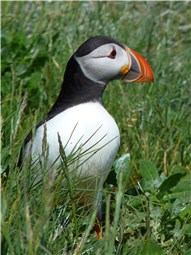
Classic Puffin shot
On the far side of the island, we looked across at the seething mass of Guillemots nesting on their ledges, with the occasional Razorbill mixed among them. They oohed and aahed like a crowd at a football match and pointed their bills upwards whenever a gull threatened to come too close, but that didn’t stop one opportunistic Herring Gull snatching a Guillemot chick right before our eyes. It made for a grim photo as the gull struggled to swallow this substantial meal.

Lunchbreak
Kittiwakes looked cosy on their nests and it was interesting to compare the varied chick development – eggs in one nest, newly hatched next door, and good-sized chicks further down the line. More Shags were nesting on this side too, plus a female Eider tucked down between some rocks, so well hidden we were upon her almost before we saw her.
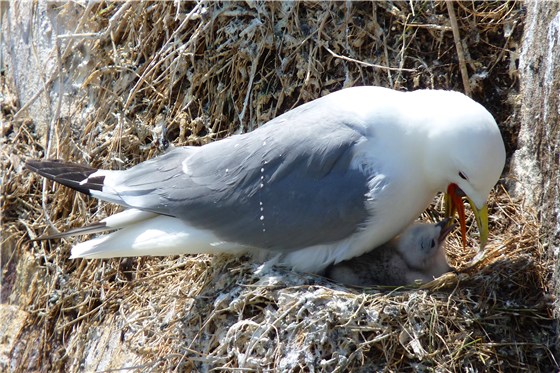
Kittiwake and chick
Back on the boat, we headed over to the Inner Farnes, where the Arctic Terns are concentrated. Feisty little birds, they didn’t like people coming too close to their nests – pretty unavoidable when they nest right on the path itself in some places. We definitely needed our hats, and next time we’ll add some padding too, to protect ourselves from the sharp billed attacks as they swooped down on the highest targets available, usually Alan or Ruth in our group. Made for a good Kodak moment though! They say it’s lucky to be hit by bird poo; well, we were very lucky that day!
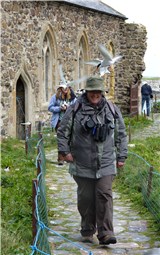
Sonia under attack!
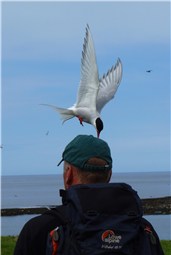
Hat attack!
The majority of nesters were Arctic Terns, beautiful birds with pale grey backs, long tail streamers, black heads and carmine red bills and dumpy legs, but in amongst them were a few Common Terns and a small gang of nesting Sandwich Terns too. Time flew by and all too soon it was time to take the boat back to the land.

Arctic Tern
Next we drove further down the coast to a calm bay and a beach empty of people but with few Little Terns diving for fish, gorgeous little birds. Just inland was a freshwater pool and we watched Shoveler and Gadwall feeding, while Reed Bunting and Sedge Warblers sang from the reed fringes, and Little Grebes dived underwater. Water Rail stalked along the edge of the water in the sunshine, totally oblivious to our presence. Such a tranquil scene after the hurly-burly of the islands.
Saturday dawned grey and wet, a real contrast to the day before. Our strategy had been to allow two days to visit the islands in case the boat trips were cancelled on the first day but we couldn’t have asked for better weather on the Friday. We checked out a local patch of woodland and encountered a Tawny Owl at a daytime roost while a Garden Warbler sang brightly from the vegetation despite the rain. We stopped to scan various freshwater pools and the estuary of Budle Bay steadily adding more birds to our list, but the rain didn’t ease, while the sea looked extremely rough. We saw a boat bravely heading out towards the Farnes; glad we weren’t on board that day!

Touching moment for Razorbills
Once the tide dropped from the causeway, we drove slowly over to Holy Island or Lindisfarne. We stopped several times on the drive across, scoping the mudflats adding Bar-tailed Godwit, Curlew and Sanderling to our list. Stopping to scan from the island iself, we enjoyed good views of a flock of Grey Plover. Checking inland, we were thrilled to see a Short-eared Owl quartering the grassy dunes. Walking out to the castle, we watched more seabirds passing and found a large group of Goosander near the harbour.
The weather calmed down as evening drew in and more Yellowhammers and a confiding Lesser Whitethroat serenaded us on the drive back to our inn.
On our last morning, in much better weather again, we checked the local woodland and had amazing views of three red squirrels, all looking extremely cute. We also added more woodland specialities to our list including Great Spotted Woodpecker, a family of Nuthatches and Coal Tit.
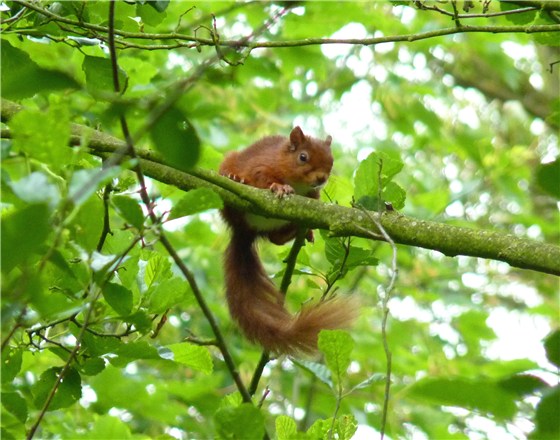
Very cute young red squirrel
We stopped off on the drive south to scan towards Coquet Island. Gannets dived in the sea just offshore, and terns filled the skies over the island and lined up on the beach. Looking through the scope we could identify Common, Arctic and Sandwich Terns, and mixed in amongst them were also a few Roseate Terns, one of which obligingly flew close past our viewpoint, allowing us all to enjoy a great look through the binoculars.
We headed south to Saltholme RSPB, where we were able to scope three Spoonbills scything through the water of the lagoon during a quick pitstop in the cafe. These views weren’t good enough though, so we headed out along the trails to get a better look. Yellow Wagtails showed off beside the path, and the Spoonbills and Avocets were all feeding close to the viewing screen. From the hide we watched a male Scaup on the water and had the chance to compare both Ringed and Little Ringed Plovers, nice to see them side by side.
The rain started lashing down again late afternoon as forecast. This was our cue to pack up and return home, but as a final goodbye just as we were leaving a weasel struggled across the road with its head held high as it carried a field mouse in its jaws. We headed home with a bird list of well over 100 species, six mammal sightings and a completely full memory card in the camera! All in all, a fantastic trip to this beautiful part of the country. We’ll definitely be going back for more next year, so if you’d like to join us please email us on
info@thebiggesttwitch.com.